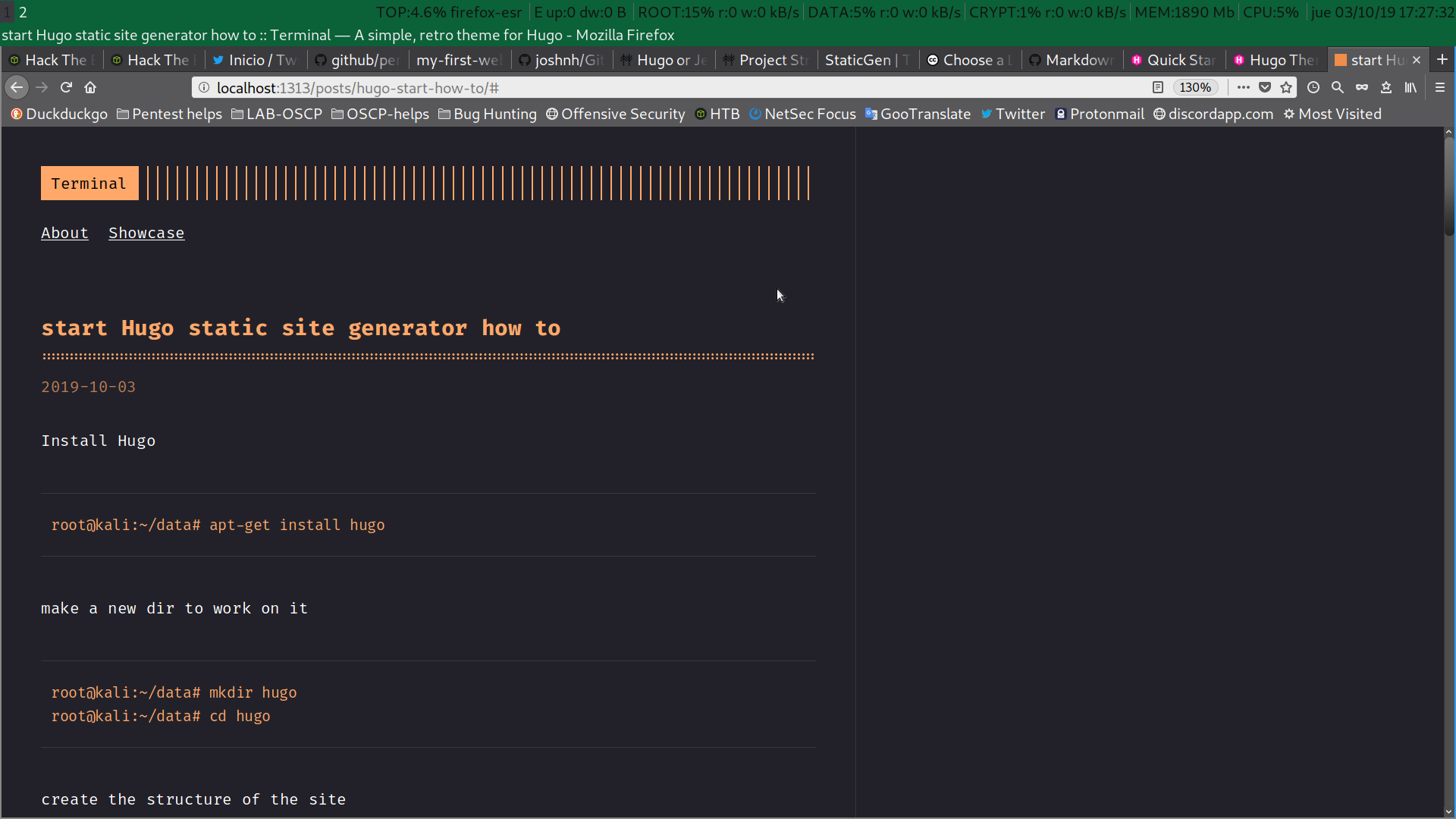Hugo Static site generator: Starting with Hugo.
Table of contents
Why Hugo
I chose hugo after comparing the [top static site gen] (https://www.staticgen.com/) and reading a couple of posts by jekyll vs hugo, everyone will have their preferences. This is the first SSG I use since for some I had to start, [Hugo’s documentation] (https://gohugo.io/documentation/) is quite broad and easy to understand.
Hugo installation
Installing Hugo will depend on the operating system we have. In Devian it is as easy as using apt.
root@kali:~/data# apt-get install hugo
After installing, we will create a new directory to work neatly.
root@kali:~/data# mkdir hugo
root@kali:~/data# cd hugo
Creation of the site structure
With Hugo we can create a [basic structure] (https://gohugo.io/getting-started/directory-structure/) for the new website.
root@kali:~/data/hugo# hugo new site viel_losero
Congratulations! Your new Hugo site is created in /root/data/hugo/viel_losero.
Just a few more steps and you're ready to go:
1. Download a theme into the same-named folder.
Choose a theme from https://themes.gohugo.io/ or
create your own with the "hugo new theme <THEMENAME>" command.
2. Perhaps you want to add some content. You can add single files
with "hugo new <SECTIONNAME>/<FILENAME>.<FORMAT>".
3. Start the built-in live server via "hugo server".
Visit https://gohugo.io/ for quickstart guide and full documentation.
Let’s see what basic structure created us.
root@kali:~/data/hugo# tree
.
└── viel_losero
├── archetypes
│ └── default.md
├── config.toml
├── content
├── data
├── layouts
├── static
└── themes
7 directories, 2 files
Creation of the git repository
Once the basic structure is created, we will enter the new website directory and start a git repository.
root@kali:~/data/hugo#
root@kali:~/data/hugo#
root@kali:~/data/hugo# cd viel_losero/
root@kali:~/data/hugo/viel_losero#
root@kali:~/data/hugo/viel_losero# git init
Inicializado repositorio Git vacío en /root/data/hugo/viel_losero/.git/
A simple list will let us see the new .git repository,
root@kali:~/data/hugo/viel_losero# ls -la
total 4
drwxr-xr-x 9 root root 125 oct 3 15:08 .
drwxr-xr-x 3 root root 41 oct 3 15:08 ..
drwxr-xr-x 2 root root 24 oct 3 15:08 archetypes
-rw-r--r-- 1 root root 82 oct 3 15:08 config.toml
drwxr-xr-x 2 root root 6 oct 3 15:08 content
drwxr-xr-x 2 root root 6 oct 3 15:08 data
drwxr-xr-x 7 root root 119 oct 3 15:08 .git
drwxr-xr-x 2 root root 6 oct 3 15:08 layouts
drwxr-xr-x 2 root root 6 oct 3 15:08 static
drwxr-xr-x 2 root root 6 oct 3 15:08 themes
Installing a theme as a submodule
Hugo’s test server does not start without a theme, it will give us an error. To install a hugo theme as a git submodule we can download it from https://themes.gohugo.io/. Installing the theme as a git sub-module will allow us to keep it updated.
root@kali:~/data/hugo/viel_losero# git submodule add https://github.com/panr/hugo-theme-terminal.git themes/terminal
Clonando en '/root/data/hugo/viel_losero/themes/terminal'...
remote: Enumerating objects: 779, done.
remote: Total 779 (delta 0), reused 0 (delta 0), pack-reused 779
Recibiendo objetos: 100% (779/779), 1.91 MiB | 869.00 KiB/s, listo.
Resolviendo deltas: 100% (407/407), listo.
Chosen the theme. I have chosen [terminal] (https://themes.gohugo.io/hugo-theme-terminal/) for this test, we will copy the initial configuration as the creator suggests,
root@kali:~/data/hugo/viel_losero# cat <<EOF>config.toml
baseurl = "/"
languageCode = "en-us"
theme = "terminal"
paginate = 5
[params]
# dir name of your blog content (default is `content/posts`)
contentTypeName = "posts"
# ["orange", "blue", "red", "green", "pink"]
themeColor = "orange"
# if you set this to 0, only submenu trigger will be visible
showMenuItems = 2
# show selector to switch language
showLanguageSelector = false
# set theme to full screen width
fullWidthTheme = false
# center theme with default width
centerTheme = false
# set a custom favicon (default is a `themeColor` square)
# favicon = "favicon.ico"
[languages]
[languages.en]
languageName = "English"
title = "Terminal"
subtitle = "Vel006 public things"
keywords = ""
copyright = ""
menuMore = "Show more"
readMore = "Read more"
readOtherPosts = "Read other posts"
[languages.en.params.logo]
logoText = "Terminal"
logoHomeLink = "/"
[languages.en.menu]
[[languages.en.menu.main]]
identifier = "about"
name = "About"
url = "/about"
[[languages.en.menu.main]]
identifier = "showcase"
name = "Showcase"
url = "/showcase"
EOF
Creating a test post
Installed the theme, we will create a new test post with the markup language [Markdown] (https://es.wikipedia.org/wiki/Markdown), this is one of the features of Hugo publish files with extension md. For the new test post I will use this own .md file of notes on the installation and testing of Hugo.
root@kali:~/data/hugo/viel_losero# hugo new posts/hugo-start-how-to.md
root@kali:~/data/hugo/viel_losero# vi content/posts/hugo-start-how-to.md
Once everything is ready, we start the local test server that comes with Hugo to see the result.
root@kali:~/data/hugo/viel_losero# hugo server -D
Finally we will take a screenshot of the result and add it to the post.
root@kali:~/data/hugo/viel_losero# mkdir static/images
root@kali:~/data/hugo/viel_losero# cp /root/Imágenes/Captura\ de\ pantalla\ -2019-10-03\ 17-27-33.png static/images/hugo-dev.png
Result
Here we have the screenshot with the result of my first test with Hugo.

back
References:
License: CC-BY-SA
